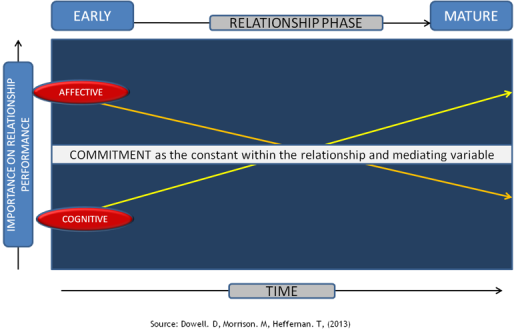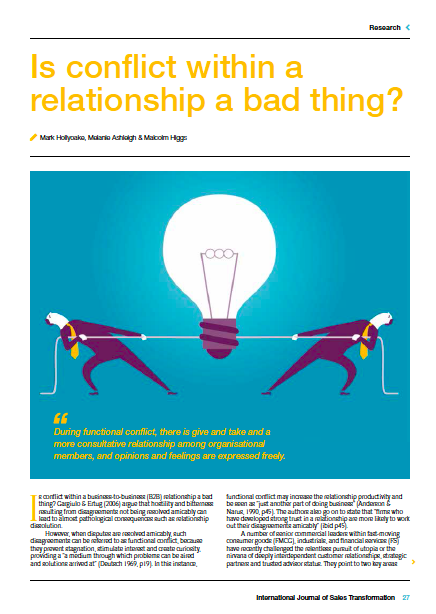Is conflict within a B2B relationship a bad thing? Part 2 of 3
Our second blog on conflict within B2B relationships focuses on some of the unanticipated downsides arising from strongly bonded trust relationships.
This blog has been published in The Journal of Sales Transformation – scroll down to read the full article.
High levels of trust in B2B create strong bonds of familiarity and mutual understanding. While they are key to co-operation, they can inadvertently create a gate-keeping function which blocks critical information reaching partners; this results in a cognitive ‘lock-in’ that isolates the organisation from the outside world, and can make high trust relationships extremely resilient to losses in their instrumental value. In essence, excessive trust in one’s partner delays the triggering of corrective action facing an objective performance decline. This in turn may cause larger and more sustained losses in benefits for the trusting party before corrective action is ultimately engaged upon.
During numerous conversations within the financial services sector this type of relationship surfaced as a key cause of conflict for the management team. The relationship is controlled through one person in conjunction with an opposite number operating in a similar way. It is unclear who owns the relationship and over-dependence masks relationship benefit shortfalls. A study by Dowell (2013) demonstrates that mature relationship performance is dependent upon cognitive trust (competence) – see Fig 1. This means an organisation which is still applying affective elements (relational, liking & intuition) may fail to realise true potential from the relationship.
Fig 1.
Within the FMCG retail sector we have seen the opposite occur, with large retailers rotating the buying team on a regular basis to prevent the development of relationships that don’t advantage the retailer. It would be interesting to analyse the increase in the cost to serve as suppliers mitigate against this approach within their commercial terms – fortunately, a level of common sense seems to have prevailed to redress the balance with the emergence of joint development, joint action and joint business planning initiatives for the more pro-active suppliers.
Putting two together we can apply two dimensions: one that focuses on the development of excessive trust; the other focuses on the relational dynamic that accompanies this of over-dependence.
How do we remedy over dependence?
One interviewee who identified over-dependence as an issue within their organisation implemented a policy within the customer management team to rotate account managers and client directors every five years – not all at the same time! This approach retains high levels of strategic customer insight, trust and joint development potential, without the relationship tipping into over dependence. However, he argues to get a new team up and running within 3 months relies on an effective CRM system as the enabling platform.
In our next blog in the Conflict series we focus on how we can we prevent the relationships from getting over-dependent.
Part 3 will be available next Wednesday.
Read the full article featured in The International Journal of Sales Transformation by clicking on the images below.
If you’d like to know more about The International Journal of Sales Transformation, click here.
Have a view on this? Tweet to @customerattune or Tweet to @MarkHollyoake
- Excessive Trust – When Trust Goes Wrong - October 29, 2024
- Identification Based Trust - October 21, 2024
- Introducing Knowledge Based Trust - October 15, 2024




